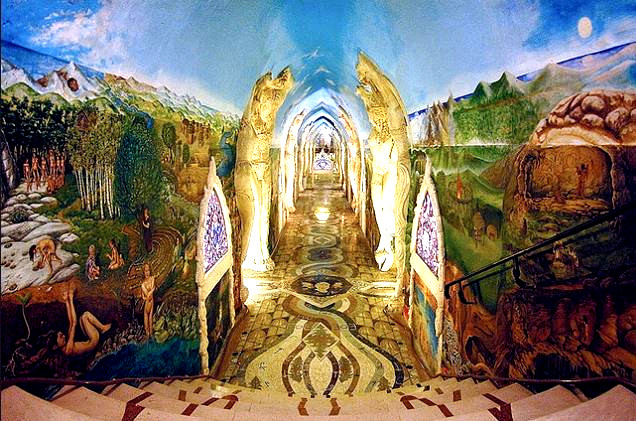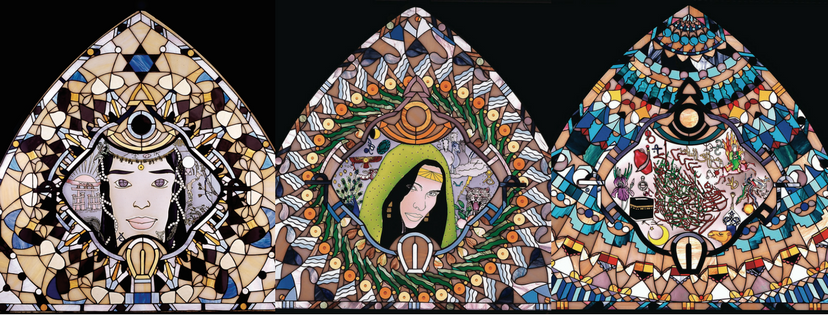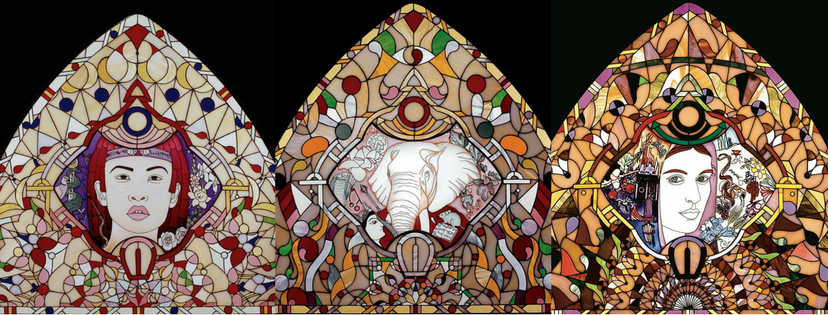The Hall of the Labyrinth is one of the Halls of the Temples of Humankind which presents the greatest number of cultural and spiritual references to different experiences. Visitors to the Temples are struck by the richness and personality of the other rooms, and then are happy to find in the Labyrinth also images, signs and symbols familiar to them. These are images that refer to forms of worship present in the history of their countries, which are studied at school or meet at the theater and in the library, or even that they are part of their current spiritual choices.

The Labyrinth is a house that welcomes everyone: all the Gods in the history of humanity. Not all are represented, due to limited space, but all are ideally present and consequently all spiritual seekers, the faithful of some religions and the mystics they refer to traditions that are still alive.
What’s in this room?
There are thirty-five windows dedicated to each one of the names that the Divine has assumed in the history of the peoples. In practice, thirty-five deities, thirty-five forms of worship are present in the hall. They range from stained glass windows dedicated to the great religions still present on the Planet – Christianity, Islam, Judaism, Shintoism, Buddhism and Hinduism, to forms of religiosity related to the pantheon of the classical peoples, lived in all ages and at all latitudes.
This hall, say the artists who created the Temples, is the one that required the greatest care and the most study: in fact at the base there are thirty-five windows in which there is a detailed study of the various “divine persons”, of the correspondences between the names with which they are known and the ancient symbols with which the people have represented them. At the base of each of the thirty-five windows there is a very careful, long and demanding philological work, which makes this room a three-dimensional book on mythologies, religions and on the ancient and modern traditions of humanity.
Why has Damanur created an environment like this?
In the vision proposed by Falco Tarassaco and developed by his spiritual children, each of these windows show something very similar and deeply different. A unifying thought is that which invites all human beings and all peoples to recognize the presence of a sphere of existence that we call “divine”, composed of creatures that have characteristics and prerogatives that are wider than those of human beings and that can support the path of men towards spiritual growth. Human beings are interested in contact with the divine forces just as the divine forces are interested in contact with peoples, because through them they can experience the material world. From this point of view, this is a reciprocal exchange type of relationship.
Conceptions that are very different, are those that instead distinguish the way in which we can approach these forces: the cultures of divine transcendence, for example, the religions of ” the Book”, that is Christianity, Islam and Judaism, establish that there is enormous distance between one dimension and the other, and only the devotion of humans to Gods can make contact possible after death. Other conceptions instead affirm that contact with one’s God/Gods is possible through sensitive experiences, through personal discipline and daily life. This Hall is, evidently, the house that welcomes them all, in the name of the points that unite the different conceptions, considering that the Truth is a crystal that has a thousand faces and each of them deserves respect.

A revolutionary concept
The Labyrinth presents an aspect perhaps never seen in all sacred architecture: images and symbols of different Divinities, belonging to epochs, geographical areas, very different spiritual conceptions, are together and cohabit in the same space. This will be even more evident when, probably at the end of 2018, the expansion of this hall will be inaugurated. The Labyrinth will then host not only new windows, but also wall paintings in which the Deities dialogue, collaborate and compare. It is the pacified and united divine plan, it is peace in the world, among peoples. The Labyrinth, at Damanhur, is a place not to get lost but to travel on a straight path to the light.







